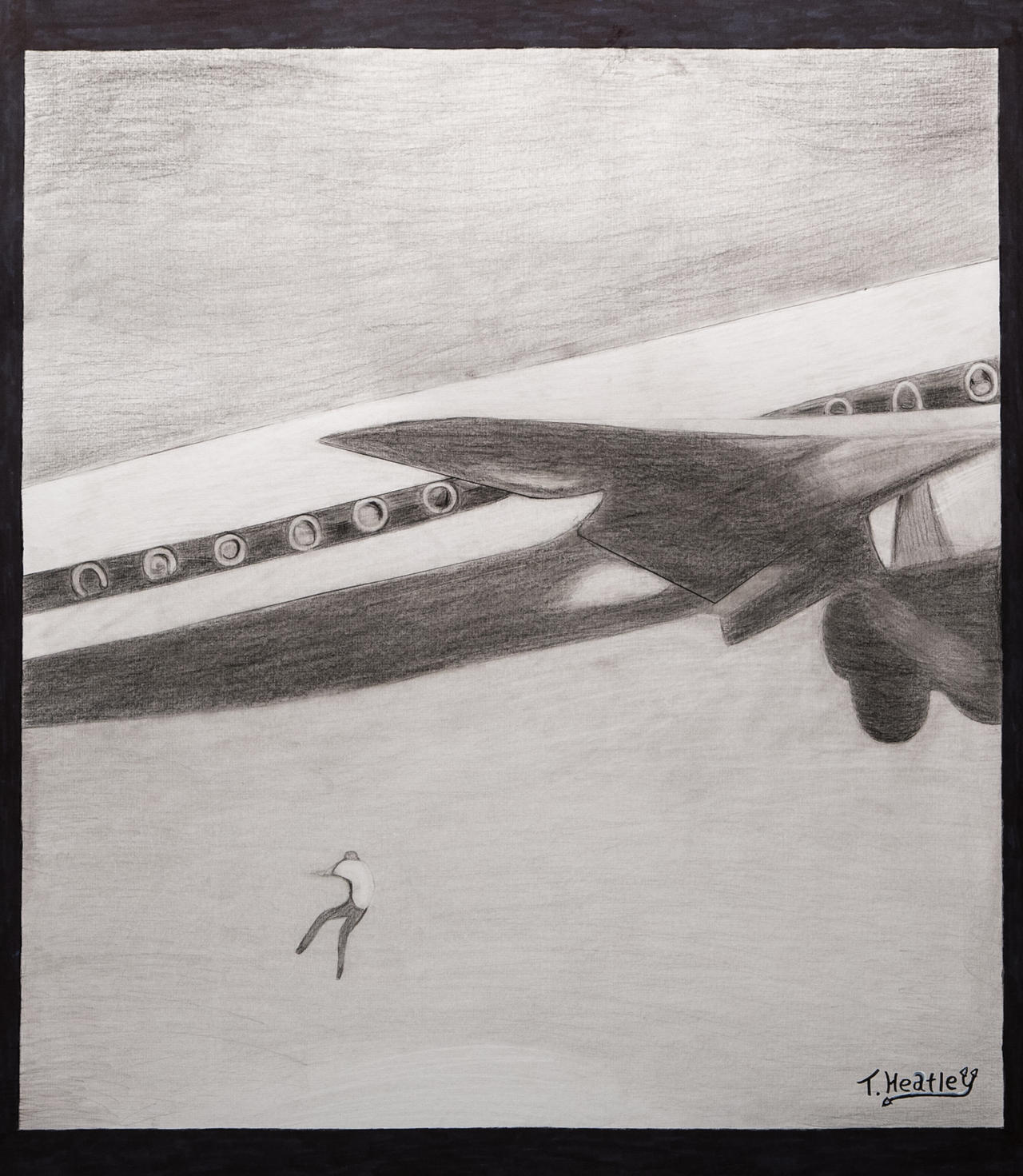Contents Overview
- An Introduction to the Tragic Story
- Life and Times of Keith Sapsford
- Personal Details and Background
- Curiosity and the Path to the Incident
- The Incident: An Unfolding Tragedy
- The Investigation: Uncovering the Truth
- Psychological Insights: The Appeal of Risky Behavior
- Societal Reflection: Learning from the Tragedy
- Modern Aviation Safety Measures
- Final Thoughts: Reflecting on Life's Fragility
An Introduction to the Tragic Story
The life and untimely death of Keith Sapsford serve as a poignant reminder of the dangers that can arise when youthful curiosity meets impulsive decision-making. Keith Sapsford, an Australian teenager, met a tragic end on February 21, 1970, when he attempted to stow away on a Japan Airlines flight departing from Sydney Airport. His story, captured in a haunting photograph, has left an indelible mark on the aviation industry and the public consciousness.
This exploration delves into the life of Keith Sapsford, examining the circumstances that led him to take such a perilous risk. We also analyze the broader implications of his actions, including psychological and societal factors that contribute to risky behavior among young people. By understanding Keith's story, we gain insights into the importance of safety protocols and the need to guide young individuals toward safer choices.
This narrative is not just about a single tragedy but also about the lessons we can draw from it. By honoring Keith's memory, we aim to shed light on the circumstances surrounding his death and prevent similar incidents in the future.
Read also:Exploring The World Of Ultra Hd The Impact Of 4k Hindi Movies
Life and Times of Keith Sapsford
Born on January 14, 1954, in Sydney, Australia, Keith Sapsford grew up in a modest household, where his adventurous spirit and curiosity were evident from an early age. Those who knew him described him as a young man with a zest for exploration, always seeking out new experiences and pushing boundaries. However, his adventurous nature often led him into challenging situations, as he struggled to find direction in life.
By the time Keith reached his teenage years, he faced numerous difficulties, both at home and at school. These challenges likely contributed to his growing sense of restlessness. Friends and family recall that Keith often spoke of his desire to escape his circumstances and explore the world, despite lacking the means to do so. This deep-seated desire for adventure ultimately led to the fateful decision that ended his life tragically.
On February 21, 1970, Keith's life intersected with aviation history in a way that no one could have anticipated. His attempt to stow away on a Japan Airlines flight from Sydney Airport became a defining moment for his family, the aviation industry, and the broader public. The photograph capturing his fall from the plane remains a somber reminder of the consequences of youthful curiosity and risky behavior.
Personal Details and Background
| Full Name | Keith Sapsford |
|---|---|
| Date of Birth | January 14, 1954 |
| Place of Birth | Sydney, Australia |
| Date of Death | February 21, 1970 |
| Place of Death | Sydney Airport, Australia |
| Age at Death | 16 years old |
| Known For | Stowaway incident and tragic fall from a Japan Airlines flight |
Curiosity and the Path to the Incident
At the core of Keith Sapsford's story lies the universal theme of youthful curiosity and the desire for adventure that often characterizes adolescence. Many young people during this transformative period are driven by an intense need to explore the unknown and push boundaries. For Keith, this curiosity manifested in his fascination with aviation and the allure of distant lands.
Several factors likely contributed to Keith's decision to attempt such a dangerous act. First, his challenging home environment may have played a significant role. Reports suggest that Keith faced difficulties at home, which could have fueled his desire to escape. Additionally, his struggles at school left him feeling disconnected and searching for a sense of purpose. These personal challenges, combined with a yearning for adventure, created a volatile mix that led to his ill-fated decision.
The cultural context of the 1960s and 1970s also cannot be overlooked. During this era, the world was undergoing significant changes, and the idea of travel and exploration was heavily romanticized in popular culture. For a young person like Keith, the prospect of boarding a plane and embarking on an international journey must have seemed like the ultimate escape from his troubles. Unfortunately, his lack of awareness about the dangers involved proved to be fatal.
Read also:Discovering Laurel Ventimiglia A Rising Star In The Entertainment Industry
The Incident: An Unfolding Tragedy
The events of February 21, 1970, unfolded rapidly but left a lasting impact on history. On that day, Keith Sapsford managed to sneak onto the tarmac at Sydney Airport and climb into the wheel well of a Japan Airlines flight bound for Tokyo. Unbeknownst to him, the conditions inside the wheel well were far from survivable. As the plane ascended, the extreme cold and lack of oxygen would have quickly rendered him unconscious.
Tragically, Keith's body fell from the plane shortly after takeoff, landing on the airport grounds below. The moment was captured in a haunting photograph taken by John Gilpin, a local resident testing his new camera. This image, showing Keith mid-fall, became an iconic representation of the fragility of human life and the consequences of reckless behavior.
This photograph not only shocked the public but also sparked widespread discussions about airport security and the dangers of stowaway attempts. At the time, security measures were far less stringent than they are today, allowing Keith to access restricted areas without detection. His death served as a wake-up call for the aviation industry, prompting a reevaluation of safety protocols to prevent similar incidents in the future.
The Investigation: Uncovering the Truth
Following Keith Sapsford's tragic death, authorities launched a thorough investigation to determine how such an incident could occur. The inquiry revealed significant lapses in airport security that allowed Keith to access the tarmac and board the plane undetected. Eyewitness accounts and interviews with airport personnel painted a picture of a system that was ill-equipped to handle unauthorized intrusions.
Experts who reviewed the case highlighted several critical issues. First, the lack of perimeter fencing and inadequate surveillance made it easy for individuals to enter restricted areas. Additionally, there were no protocols in place to monitor the wheel wells of departing aircraft, leaving them vulnerable to stowaways. These findings underscored the urgent need for improved security measures to protect both passengers and individuals like Keith.
Furthermore, the investigation shed light on the broader phenomenon of stowaway attempts. While Keith's case was particularly shocking due to the photograph capturing his fall, it was not an isolated incident. Historical records show that stowaways have attempted to board planes for various reasons, including economic hardship and a desire for adventure. Keith's story served as a catalyst for addressing these underlying issues and implementing stricter safety regulations across the aviation industry.
Psychological Insights: The Appeal of Risky Behavior
To fully understand Keith Sapsford's actions, it is essential to explore the psychological factors that drive young people to engage in risky behavior. Adolescence is a period of significant cognitive and emotional development, during which individuals often exhibit heightened impulsivity and a desire for novelty. For Keith, these traits may have played a crucial role in his decision to attempt such a perilous act.
Impulsivity and Risk-Taking
Research shows that the adolescent brain prioritizes immediate rewards over long-term consequences. This tendency, combined with underdeveloped decision-making skills, can lead young people to underestimate the risks associated with their actions. In Keith's case, the thrill of sneaking onto a plane and the allure of international travel likely outweighed any consideration of the dangers involved.
Search for Identity and Purpose
Another key factor is the search for identity and purpose that characterizes adolescence. Many young people, including Keith, struggle to find their place in the world and may turn to risky behaviors as a way to assert independence or escape their circumstances. This need for self-discovery can sometimes manifest in reckless decisions, as individuals seek to define themselves through bold actions.
Influence of Social and Cultural Factors
Social and cultural influences also play a significant role in shaping adolescent behavior. During the 1960s and 1970s, the idea of travel and exploration was heavily romanticized, creating a powerful allure for young people like Keith. Additionally, peer pressure and societal expectations may have contributed to his desire to take risks, as he sought validation and a sense of belonging.
Societal Reflection: Learning from the Tragedy
Keith Sapsford's story had a profound impact on society, sparking conversations about the importance of safety, security, and the need to address the root causes of risky behavior among youth. His tragic death served as a wake-up call for both the aviation industry and the broader public, prompting significant changes in policies and attitudes.
One of the most immediate outcomes of the incident was the implementation of stricter security measures at airports worldwide. Following Keith's death, authorities recognized the need to prevent unauthorized access to restricted areas and introduced measures such as improved perimeter fencing, enhanced surveillance systems, and increased personnel presence. These changes not only helped to protect passengers but also reduced the likelihood of similar stowaway incidents in the future.
On a broader level, Keith's story highlighted the importance of addressing the psychological and social factors that contribute to risky behavior among young people. It prompted educators, parents, and policymakers to focus on fostering environments where adolescents feel supported and valued, reducing the likelihood of them seeking validation through dangerous actions. By learning from Keith's tragedy, society has taken steps to create a safer and more understanding world for future generations.
Modern Aviation Safety Measures
In the decades following Keith Sapsford's tragic death, the aviation industry has undergone significant transformations to enhance safety and security. These changes have been driven not only by incidents like Keith's but also by broader concerns about terrorism, smuggling, and unauthorized access to aircraft. Today, airports and airlines implement a wide range of measures to prevent stowaway attempts and ensure the safety of all passengers.
One of the most visible improvements is the implementation of advanced perimeter security systems. Modern airports are equipped with high fences, motion sensors, and surveillance cameras to deter and detect unauthorized intrusions. Additionally, security personnel are trained to monitor sensitive areas, such as runways and aircraft parking zones, to prevent individuals from accessing restricted spaces.
Technological advancements have also played a crucial role in enhancing aviation safety. Many aircraft are now equipped with sensors and alarms designed to detect anomalies, such as unexpected weight in the wheel well. These systems provide an additional layer of protection, alerting ground staff and pilots to potential security breaches before takeoff. Furthermore, international aviation organizations have established guidelines and best practices to ensure consistent safety standards across the industry.
Despite these advancements, the aviation industry remains vigilant, recognizing that safety is an ongoing process. By continuously evaluating and updating security measures, airports and airlines strive to prevent incidents like Keith Sapsford's and ensure that air travel remains one of the safest modes of transportation.
Final Thoughts: Reflecting on Life's Fragility
Keith Sapsford's story is a poignant reminder of the delicate balance between youthful curiosity and the consequences of impulsive decisions. His tragic death not only shocked the world but also prompted significant changes in aviation safety and societal attitudes toward risk-taking behavior. By examining the factors that led to his fateful decision and the lessons learned from his story, we gain valuable insights into the importance of fostering environments where young people feel supported and guided toward positive choices.
We invite you to reflect on the lessons of Keith's story and consider how we can create a

